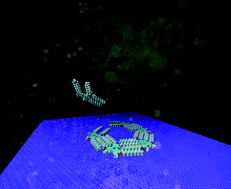Design of efficient sergeant molecules for chiral induction in nano-porous supramolecular assemblies†
Abstract
In this study molecular modeling is used to investigate the transfer of chirality from the molecular level to homochiral, nano-porous 2D networks in self-assembled monolayers at the liquid/graphite interface. This allows proposing design rules for sergeant molecules for inducing chiral supramolecular assembly in nano-porous monolayers.


 Please wait while we load your content...
Please wait while we load your content...